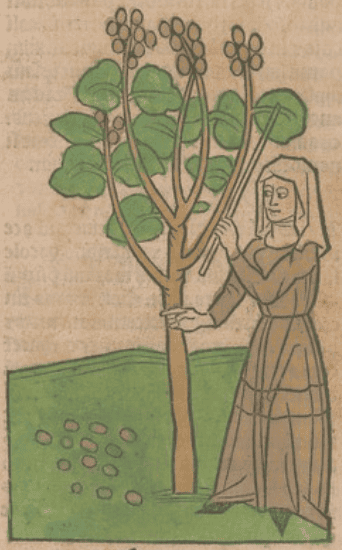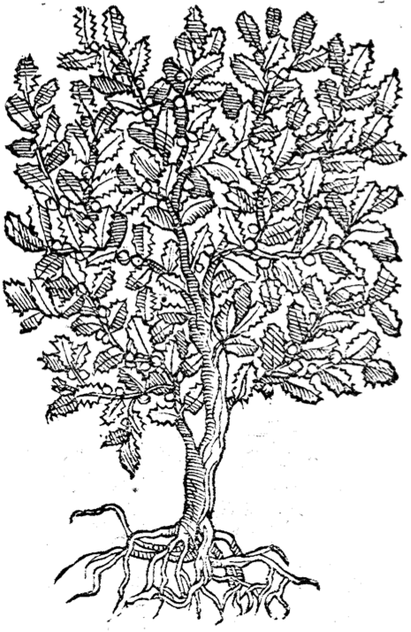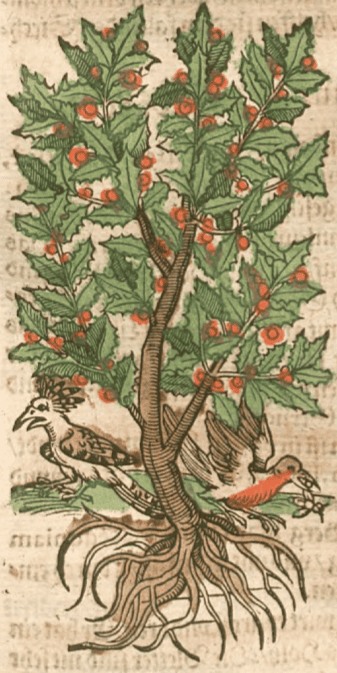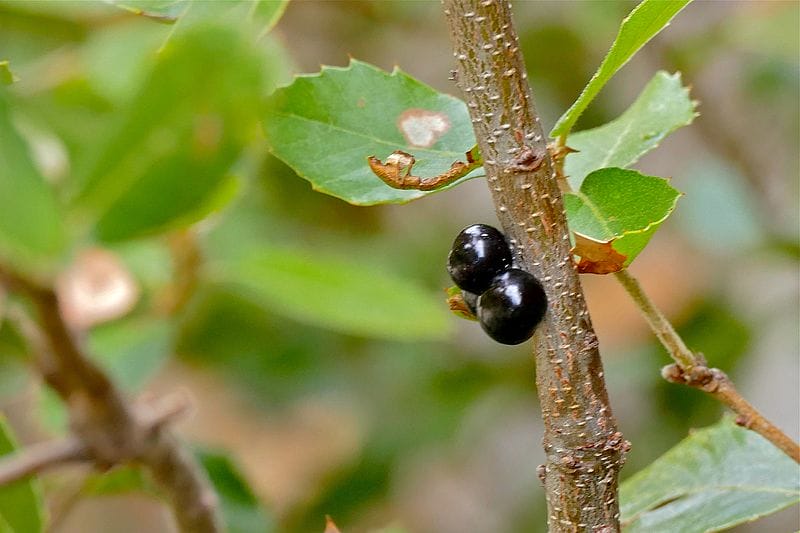Kermes
Kermes, Chermes; Kermes Grains; Alhermes; Dying Grains; Grana Tinctorum; Coccum Baphica; Coccus infectorium; Coccus of the Oak Ortus Sanitatis, Meydenbach, 1491
Ortus Sanitatis, Meydenbach, 1491

|

|
|
Illex coccifera Dioscorides Materia Medica, Mathias, 1563 |
Krauterbuch, Lonitzer, 1578 |
 Coccus illicis on Holm Oak
Coccus illicis on Holm Oak(Photo by Bernard DUPONT) (Wikimedia)
Entomological name:
Insect of Coccus illicis (syn. Kermes illicis) on Illex coccifera
Parts used:
Insect Eggs laid on branches of Scarlet Oak
Temperature & Taste:
Cool (some said Hot), dry. Bitter, Pungent
Uses:
1. Benefits the Heart, Calms the Spirit:
-Cordial, refreshes the Vital Spirits
-‘refreshes a weary carcase’.
2. Resists Poison, Clears Heat:
-used to ‘Discuss evil vapors’
-Erysipelas and Venereal Sores
3. Promotes Expression of Rashes:
-Measles and Small Pox in particular.
-resists infection during Epidemics including the Plague.
4. Moves the Blood, Promotes Labor:
-half dram taken in an Egg
5. Benefits the Lungs, Stops Cough:
-Cough; Lung weakness
6. Externally:
-Wound medicines; cures Wounds of the Nerves.
-red cloth (dyed with Kermes) was often used externally by poor folk to ward off infection, and to cure Evil sores and infectious diseases. The cloth was wrapped around one with Small Pox, for which purpose it was said to be ‘famous’. Also applied to Venereal Sores and Erysipelas etc. It was worn by children to protect the Heart and strengthen the Spirit.
Preparation:
1. They were prepared by drying them on linen cloth after being sprinkled with strong vinegar to prevent the small eggs from hatching. When dry, the eggs fall into a red powder which was usually separated from the husk by sieving. The husk were then formed into balls which was filled with the red powder for export.
2. Sometimes the fresh juice expressed was made into a syrup with Sugar and exported in this form. This was the method especially used in Southern France.
3. An extract was prepared from the fresh Kermes in Brandy, Sherry or Rose water, made sharp with a few drops of Sulphuric acid.
Dose:
500mg–2 grams
Main Combinations:
1. To strengthen in wasting or recuperation:
i. with Chocolate powder (Fuller)
ii. Almond, Conserve of Rose, Juice of Kermes
2. To strengthen the Heart:
i. Juice of Kermes with Conserve of Lemon peel, Candied Citron peel, Candied Green Ginger, Oil of Cinnamon (Fuller)
ii. Conserve of Gilly-flowers, Conserve of Rosehip, Rob of Raspberry, Rob of Currants (Fuller)
iii. Conserve of Rose, Conserve of Borage flower, Candied Citron peel, beat with Waters of Borage and Rose, then add Juice of Kermes, Lemon juice, Syrup of Raspberry. (Fuller)
iv. Clove, Saffron, Spirit of Lavender, Syrup of Gilliflower, Juice of Kermes, Gold leaf (Golden Julep, Fuller)
3. To cheer the Heart and Spirit, strengthen Digestion, and strengthen Mother with Child, Sherry wine (½ pint), Cinnamon Water (4 oz.), Rose Water, White Sugar Candy (each 2 oz.), Juice of Kermes (1 oz.), Letificans Galeni powder, Gold leaves (4), Oil of Nutmeg (4 drops). (Fuller)
4. As an Aphrodisiac, with Orchis root, Candied Sea Holly root, Candied Nutmeg, Long Pepper (Fuller)
Cautions:
None noted.
Main Preparations used:
Tincture, Syrup, Extract
1. Tincture of Kermes:
i. Kermes in powder (2 oz.), Spirit of Wine (12 oz.) Digest 1 week, then filter.
2. Syrup of Kermes:
i. Bruised Kermes (1 part), White Sugar (3 parts). Macerate for one day in a cool place, then express the syrupy juice. (Pharmacopoeia Sardoa, 1773)
-
Extra Info
-
History
Pliny on Kermes:
‘The scarlet berry of the holm-oak is applied to fresh wounds with vinegar; and in combination with water it is dropt into the eyes in cases of defluxion of those organs or of ecchymosis. There grows also in most parts of Attica, and in Asia, a berry of this description, which becomes transformed with great rapidity into a diminutive worm, owing to which circumstance the Greeks have given it the name of ” scolecioni” it is held, however, in disesteem. The principal varieties of this berry have been previously described’.
(The Natural History of Pliny, trans. by Bostock and Riley, Vol. 5, 1856)
